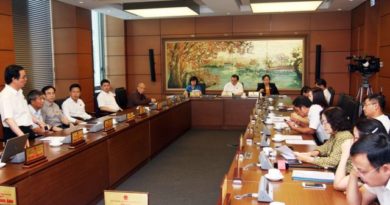Opinion | What events are keeping a brake on anti-China narratives in the Asia-Pacific?

Renowned historian Niall Ferguson recently described the emerging conflict with China over Taiwan as the Cold War II . The theory is quite daunting in that it suggested how to prevent this from becoming a hot war, and how to defuse it, or even win it.
This theory has its place given the tense rivalry between the US and China on the trade and technology fronts, supported by the EU’s attempt to contain the rise of China. In a way, the West needs a common enemy to explain its decline and win over the theory they created.
In the Asia-Pacific, the news often tells us that the war between China and the Philippines over the South China Sea is about to break out before long. Vietnam’s island building in the South China Sea has reached a record with the total new land created in the first six months of this year equaling that of 2022 and 2023 combined. The Washington-based Asia Maritime Transparency Initiative (AMTI) said in its latest report that since November 2023, Vietnam has created 692 new acres (280 ha) of land across a total of 10 features within the Spratly archipelago .
But calling the tension in Taiwan, the South China Sea or the entire U.S.-China rivalry a new Cold War is probably a difficult comparison. Maybe the proponent should have a new definition of the Cold War instead of calling it Cold War II for two reasons.
First, China is a reluctant hegemonic competitor, making it difficult to define as a Cold War. China has never attempted to export its socialist system of government to any country. What China has done is more of an act of self-defense against US attacks on trade and US’ building of alliance to contain China.
Second, China is not exactly the real enemy of the West. Instead, China has become an imaginary enemy of the West to justify the latter’s inevitable decline.
Let’s look at a real example. When the West is complaining about China’s “overcapacity”, former Singaporean foreign minister, George Yeo, treated this narrative as information warfare against China. “Look at how terrified the Europeans are, accusing China of having “overcapacity”. How can you blame China for “overcapacity” when you’re taking liberties with yourself, having long summers and working short hours…There are consequences,” he said .
While news in the Asia-Pacific often suggests anti-China narratives, three major events have clearly indicated resistance to full “decoupling,” even from countries that have close relations with the US or that are in dispute with China over territorial claims.
First is the resumption of trilateral summit between China, Japan and South Korea. The 9th Summit was conducted in Seoul on 27 May 2024 following the last one in 2019. Their final statement tells it all. The core of the statement was their determination to “keeping markets open and strengthening supply chain cooperation and avoiding supply chain disruptions”, their commitment to rule-based multilateral trade and efforts to capitalize on the Regional Comprehensive Economic Partnership (RCEP) Agreement as the basis of a Trilateral Free Trade Agreement (FTA) .
Second is the resumption of warmer trade relations between China and Australia. Chinese Premier Li Qiang paid an official visit to Australia from June 15 to 18. He made a visit to Australia’s popular winery Penfolds, raising hope that Australian wine exports to China could soon bounce back after China removed the punishing tariffs in March this year, restrictions that have dilapidated a $1.2 billion export market for hundreds of local Australian wineries . Chinese Premier concluded his visit with a visit to a China-controlled lithium processing plant in Western Australia.
Australia supplies more than half of the world’s lithium, and China is one of its top customers. Lithium is a key composition for batteries that support electric vehicles and smart phones.
Third is the vocal voice of Malaysia in acting against “China-phobia”. Malaysian Prime Minister Anwar Ibrahim has advocated for balanced relations with both China and the US, and condemned the “China-phobia” narratives even if Malaysia is one of the claimants over the South China Sea. He has raised repeatedly this concern, well before the recent visit by Premier Li Qiang to Malaysia.
Anti-China narratives will continue despite the resistance mentioned above. However, it is also imperative that China engages more actively with countries in the Asia-Pacific region to take full advantage of resistance to “decoupling.” Due to domestic economic problems, it appears that China has slowed its overseas focus, as indicated by the slowdown in outbound tourism and investment in the region.
The last time President Xi Jinping visited Cambodia, which is one of China’s most reliable friends in the Asia-Pacific region, was in October 2016. Perhaps the next visit of the President Xi Jinping in the region, including Cambodia, will be able to give a powerful boost to confidence in the Asia-Pacific to overwhelm anti-China and China-phobia narratives.
For the specific context of Cambodia, realizing President Xi Jinping’s next state visit to Cambodia can be one of the biggest missions to be carried out by the new ambassador, Wang Wenbin, who was the spokesperson of the Chinese Foreign Ministry and the face of China to international media to counter the anti-China smearing campaign.
He is very warmly welcomed in Cambodia.
EDITOR IN CHIEF



 Memento Maxima Digital Marketing
Memento Maxima Digital Marketing







